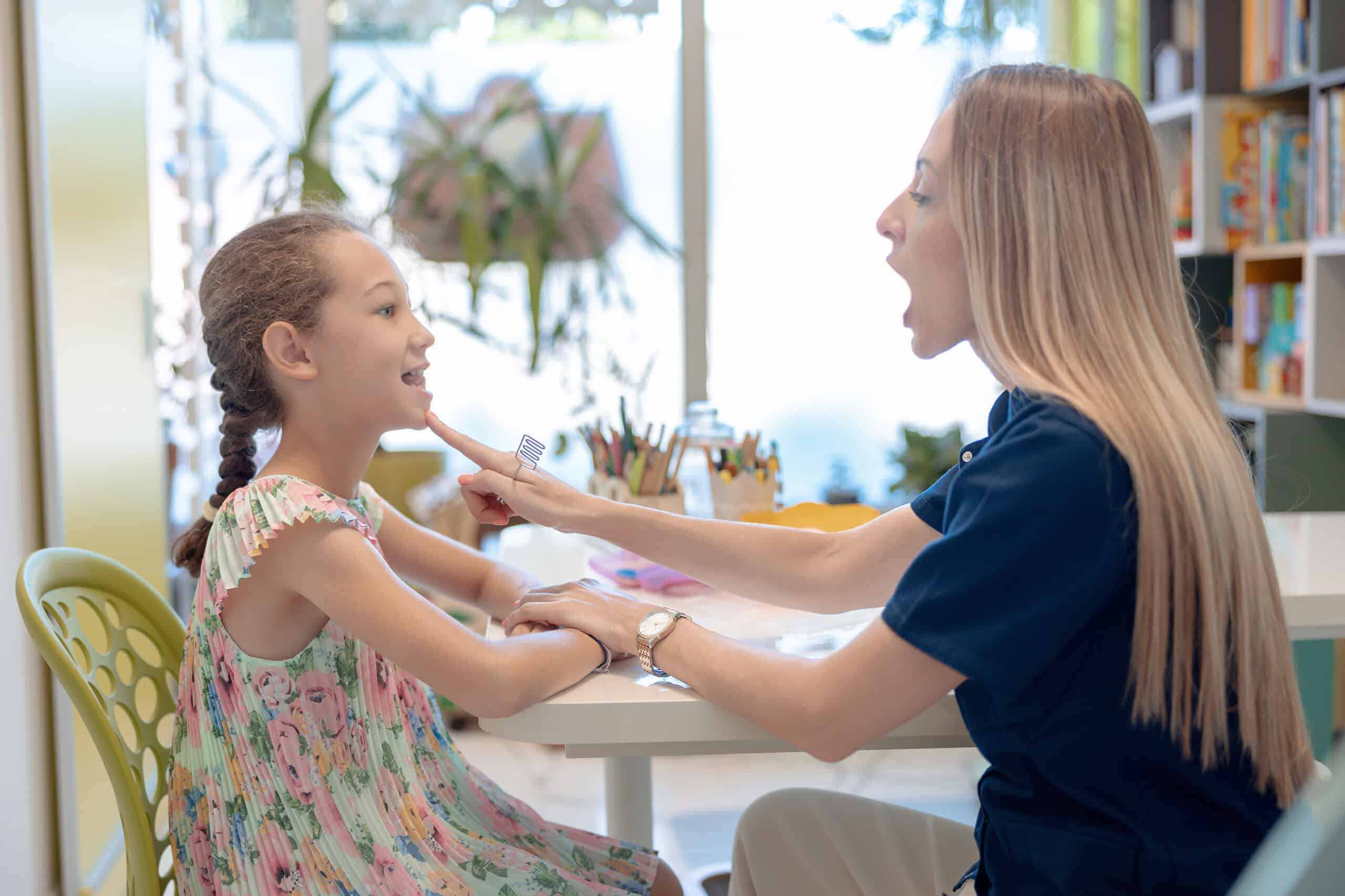
Does your child breathe through their mouth instead of their nose? Do they have difficulty forming certain sounds clearly, complain that their jaw hurts, or have problems swallowing? These can be signs of an orofacial myofunctional disorder (OMD), a condition that affects how the muscles of the mouth, face, and tongue work together.
Most OMDs are caught early in childhood, but it’s not unusual for teens or adults to experience them, too. The good news is that with orofacial myofunctional therapy (OMT) from a qualified speech-language pathologist, you or your child can learn new habits that support clear speech, proper breathing, and healthy oral development.
What Is an Orofacial Myofunctional Disorder?
An OMD is a motor function issue that affects how the muscles of the face, tongue, and jaw work together for everyday tasks like breathing, chewing, swallowing, and speaking. These muscle movement patterns can develop from early habits or physical conditions such as:
- Prolonged thumb sucking or pacifier use
- Blocked nasal passages, allergies, or enlarged tonsils
- Limited tongue movement from a tongue-tie
- A high or narrow palate, crowded teeth, or bite misalignment
- Weak or uncoordinated oral muscles
Signs of an Orofacial Myofunctional Disorder
Signs you or your child may have an OMD include:
- Breathing through the mouth instead of the nose
- Keeping the mouth open or lips apart when resting
- Having trouble saying certain sounds like “sss,” “sh,” or “ch”
- Pushing the tongue forward when swallowing or speaking
- Snoring, restless sleep, or waking up tired
- Drooling or food falling from the mouth while eating
- Having speech that sounds unclear
- Experiencing facial pain or chronic headaches
If you recognize several of these signs in you or your child, you may benefit from scheduling an evaluation with a speech-language pathologist who specializes in oral motor function and can determine whether OMT may help.
How Orofacial Myofunctional Therapy Helps With Orofacial Myofunctional Disorder
OMT is a type of speech therapy for children and adults that retrains the muscles of your mouth, tongue, and face to move in healthier, more coordinated ways. It not only strengthens your oral muscles but also improves the way your mouth naturally rests when you aren’t speaking or eating. This includes relearning how to keep your lips closed, how your tongue should rest on the roof of your mouth, and how to breathe comfortably through your nose. Over time, these patterns become automatic, replacing old habits that can interfere with optimal speech, swallowing, and oral function.
Through OMT, you or your child can:
- Establish healthy swallowing patterns
- Improve tongue movement and flexibility
- Speak more clearly
- Chew and swallow food comfortably and efficiently
- Maintain proper tongue and lip placement
- Strengthen jaw stability and overall muscle coordination
- Breathe better at night during sleep
OMT is a growing area of expertise that’s continuing to evolve through ongoing research. Speech-language pathologists who provide this therapy often work with dentists, orthodontists, or ENT specialists to ensure any structural issues, such as dental crowding or airway blockages, are properly managed so therapy can be most effective.
What to Expect During Orofacial Myofunctional Therapy
Your speech-language pathologist will begin with an evaluation to observe how you or your child breathe, swallow, and speak, as well as the position of your tongue and lips when they’re not in use. From there, they’ll create a personalized plan designed to build strength, awareness, and coordination.
Therapy often includes:
- Practicing breathing through the nose instead of the mouth
- Strengthening and coordinating tongue and lip movement
- Improving swallowing control and addressing tongue thrust
- Refining speech clarity through targeted practice
- Becoming aware of unhealthy oral habits and learning how to correct them
- Using mirrors to see and practice correct movement patterns
- Developing jaw strength and stability to support chewing and speech
For your child, the speech-language pathologist may incorporate playful activities and games to keep practice fun and engaging, like singing, blowing into a recorder, sticking out their tongue, or holding small objects between their lips.
Why Consistency Matters With Orofacial Myofunctional Therapy
Progress in OMT takes time and steady effort, and therapy may continue for several months to a year depending on your goals. With consistency and practice, small improvements will add up over time.
Here are a few ways to ensure the most successful outcome for therapy:
- Stay on schedule. Regular therapy attendance helps your speech-language pathologist build skills step-by-step and adjust exercises as needed.
- Do your at-home exercises. Practicing daily with the activities provided by your speech-language pathologist helps reinforce what you’ve learned in sessions and keeps progress moving forward.
- Practice awareness. Remind yourself or your child to close the lips, rest the tongue on the roof of the mouth, and breathe through the nose. Over time, these small reminders become healthy habits that make a big difference.
- Celebrate consistency. Whether you or your child are in therapy, progress comes from steady participation and engagement, not pursuing perfection.
When you or your child make an effort to practice what you learn in therapy throughout daily life, those new skills start to stick, leading to lasting improvements in speech, swallowing, and breathing habits.
Reach Out to Peninsula Associates Speech Therapy Services for Support
If you’re concerned that you or your child may have an OMD, reach out to Peninsula Associates Speech Therapy Services. Since 1978, our experienced team has provided personalized speech therapy for children and adults throughout the Bay Area. We collaborate closely with families, educators, and healthcare providers to help each client build strong, confident communication skills.
Call us today at (650) 709-9780 to schedule an evaluation or speak with a speech-language pathologist trained in OMT about how therapy can help you develop new habits that support clear speech, proper breathing, and healthy oral development.

